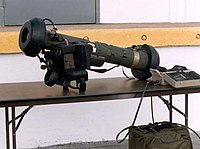
Photo from wikipedia
A chemically defined platform basal medium and feed media were developed using a single Chinese hamster ovary (CHO) cell line that produces a monoclonal antibody (mAb). Cell line A, which… Click to show full abstract
A chemically defined platform basal medium and feed media were developed using a single Chinese hamster ovary (CHO) cell line that produces a monoclonal antibody (mAb). Cell line A, which showed a peak viable cell density of 5.9 × 106 cells/mL and a final mAb titer of 0.5 g/L in batch culture, was selected for the platform media development. Stoichiometrically balanced feed media were developed using glucose as an indicator of cell metabolism to determine the feed rates of all other nutrients. A fed-batch culture of cell line A using the platform fed-batch medium yielded a 6.4 g/L mAb titer, which was 12-fold higher than that of the batch culture. To examine the applicability of the platform basal medium and feed media, three other cell lines (A16, B, and C) that produce mAbs were cultured using the platform fed-batch medium, and they yielded mAb titers of 8.4, 3.3, and 6.2 g/L, respectively. The peak viable cell densities of the three cell lines ranged from 1.3 × 107 to 1.8 × 107 cells/mL. These results show that the nutritionally balanced fed-batch medium and feeds worked well for other cell lines. During the medium development, we found that choline limitation caused a lower cell viability, a lower mAb titer, a higher mAb aggregate content, and a higher mannose-5 content. The optimal choline chloride to glucose ratio for the CHO cell fed-batch culture was determined. Our platform basal medium and feed media will shorten the medium-development time for mAb-producing cell lines.
Journal Title: Cytotechnology
Year Published: 2017
Link to full text (if available)
Share on Social Media: Sign Up to like & get
recommendations!